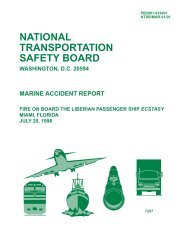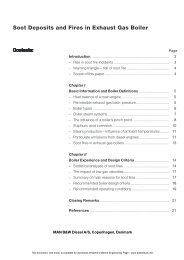CP Propeller Equipment - Martin's Marine Engineering Page
CP Propeller Equipment - Martin's Marine Engineering Page
CP Propeller Equipment - Martin's Marine Engineering Page
- No tags were found...
You also want an ePaper? Increase the reach of your titles
YUMPU automatically turns print PDFs into web optimized ePapers that Google loves.
<strong>Propeller</strong> Blade Manufacturingand MaterialsThe international standard organizationhas introduced a series of manufacturingstandards in compliance with whichpropellers have to be manufactured(ISO 484). The accuracy class is normallyselected by the customer and thetable below describes the range ofmanufacturing categories.ClassSIIIIIIManufacturing accuracyVery high accuracyHigh accuracyMedium accuracyWide tolerancesAt MAN B&W Alpha the propellerblades are checked by computerizedfour–axis measuring equipment.If no class is specified, the propellerblades will be manufactured accordingto class I but with surface roughnessaccording to Class S.Blade materials<strong>Propeller</strong> blades are made of eitherNiAl–bronze (NiAl) or stainless steel(CrNi). The mechanical properties ofeach material at room temperature are:Material NiAl CrNiYieldstrengthTensilestrengthElongationImpactstrengthCharpy VnotchBrinellHardnessN/mmN/mm%JoulesHBmin 250590–780min 1630min 150min 380600–790min 1921240–300Both materials have high resistanceagainst cavitation erosion. The fatiguecharacteristics in a corrosive environmentare better for NiAl than for CrNi.<strong>Propeller</strong> blades are, to a large degree,exposed to cyclically varying stresses.Consequently, the fatique materialstrength is of decisive importance.The dimensioning of a propeller bladeaccording to the Classification Societieswill give a 10% higher thickness forthe CrNi compared to NiAl in order toobtain the same fatigue strength.As an example the difference in thicknessand weight for a propeller blade forengine type MAN B&W 6S35MC(4,200 kW at 170 r/min) is stated in table2.CrNi–steel requires thicker blades thanNiAl–bronze, which is unfortunate fromthe propeller theoretical point of view(thicker = less efficiency). Additionally,the CrNi is more difficult to machinethan NiAl.For operation in ice the CrNi materialwill be able to withstand a higher forcebefore bending due to its higher yieldstrength and for prolonged operationsin shallow water the higher hardnessmakes it more resistant to abrasivewear from sand.The final selection of blade and hub materialdepends on the operating conditionof the vessel. In general terms theNiAl material is preferable for ordinarypurposes whereas CrNi could be an attractivealternative for non–ducted propellersoperating in heavy ice ordredgers and vessels operating in shallowwaters.Ice class C 1A*Material NiAl CrNi NiAl CrNiThickness at r/R = 0.35mm132146169187Thickness at r/R = 0.60mm717890100Thickness at r/R = 1.00mm001513Blade weightkg7298779521053Table 2Classificaton society: Det Norske VeritasThis document, and more, is available for download at <strong>Martin's</strong> <strong>Marine</strong> <strong>Engineering</strong> <strong>Page</strong> - www.dieselduck.net17
















